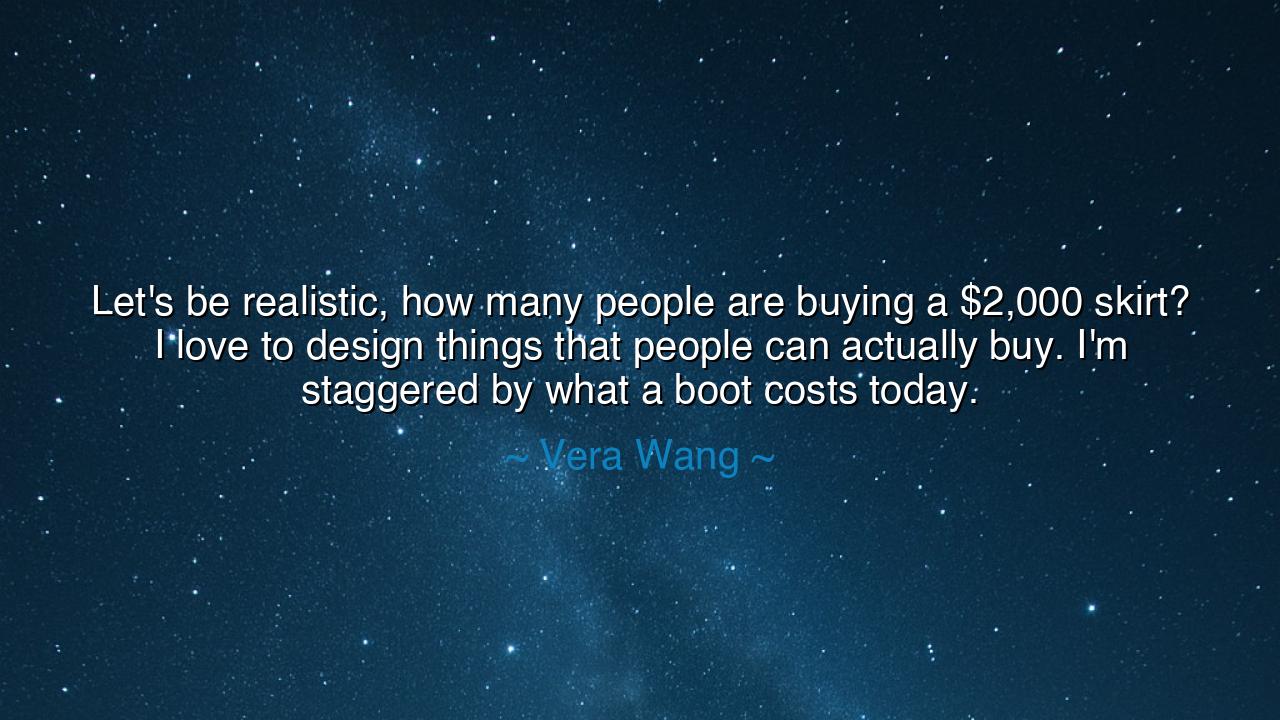
Let's be realistic, how many people are buying a $2,000 skirt? I
Let's be realistic, how many people are buying a $2,000 skirt? I love to design things that people can actually buy. I'm staggered by what a boot costs today.






The words of Vera Wang—“Let's be realistic, how many people are buying a $2,000 skirt? I love to design things that people can actually buy. I'm staggered by what a boot costs today”—may seem simple, even casual, yet they carry a deep and enduring wisdom about humility, purpose, and the true nature of creativity. In them we hear the voice of an artist who has seen both glamour and struggle, who has known the heights of luxury but has not forgotten the ground beneath her feet. These words are not only a reflection on fashion—they are a meditation on the balance between aspiration and reality, between art and humanity.
For in every age, the artist has been tempted by the glitter of the unattainable. The kings of ancient Egypt built pyramids that touched the heavens; the emperors of Rome raised palaces of marble while the streets below ran with hunger. Yet the wisest among them knew that beauty divorced from the people is an empty throne. Vera Wang, though she dwells in the modern world of couture, speaks with the same ancient truth: art must serve life, not rule it. The beauty that lives only in the hands of the few is fragile, but the beauty that meets the needs of many becomes immortal.
In her words, there is also a quiet rebellion against excess. When she says, “Let’s be realistic, how many people are buying a $2,000 skirt?,” she calls the artist back from the tower of indulgence to the field of truth. She reminds us that creation must not lose sight of compassion. To design something “that people can actually buy” is to honor the everyday human being—the worker, the mother, the dreamer who longs for beauty in the midst of ordinary life. This is not the surrender of artistry; it is its fulfillment. For what good is the song if no one can hear it? What worth is the garment if no one can wear it?
Consider the example of William Morris, the craftsman and poet of the nineteenth century, who sought to bring artistry into the homes of common people. At a time when the machine had stolen the soul of design, he revived the art of the handmade, not to flatter kings, but to uplift the humble. Yet even he found that his creations, too beautiful and too costly, were beyond the reach of those he wished to serve. Vera Wang’s lament echoes his struggle across time: that art must always strive to bridge the gap between dream and accessibility, between the divine and the daily.
When she declares, “I’m staggered by what a boot costs today,” it is not only a complaint of price—it is an expression of moral astonishment. It is the cry of the artist who values integrity over indulgence. For she knows that design should not be a monument to vanity, but a conversation with reality. Beauty should never be bought at the price of disconnection. Like the philosopher Confucius, who taught that virtue lies in moderation, Vera reminds us that greatness in creation comes not from extravagance, but from harmony—from the meeting point between elegance and empathy.
And yet, her realism is not a denial of ambition. It is, rather, the grounding of ambition in service. She does not scorn the luxury of art, but she seeks to root it in meaning. The sculptor who chisels from marble must still remember the quarryman who breaks the stone. The designer who creates for the world must never forget the world she designs for. To be “realistic,” as Wang says, is not to diminish one’s dream—it is to ensure that the dream can live, breathe, and bless others beyond the walls of privilege.
Let this, then, be the teaching for all who create: make beauty that is generous. Whether you build, write, paint, or design, let your work serve life and not only prestige. Do not measure success by price or applause, but by connection—by how deeply your work touches the hands and hearts of others. The truest artist is not the one who dazzles from afar, but the one who brings light to the lives that surround them.
For in the end, Vera Wang’s wisdom stands as a call to balance—to create not for the few, but for the many; not to exalt the rare, but to dignify the real. “Let’s be realistic,” she says—and in those words lies not limitation, but liberation. To be realistic is to be humane, to see clearly the beauty that dwells in imperfection, and to craft with a love that reaches beyond wealth or fame. For art that lives among the people, like sunlight on common ground, is the kind that never fades.






AAdministratorAdministrator
Welcome, honored guests. Please leave a comment, we will respond soon